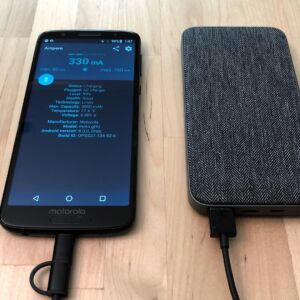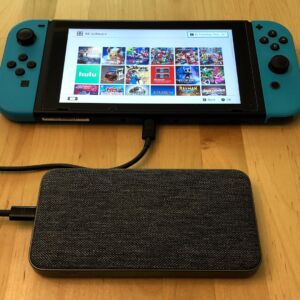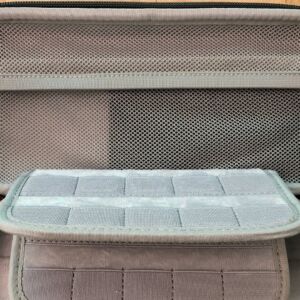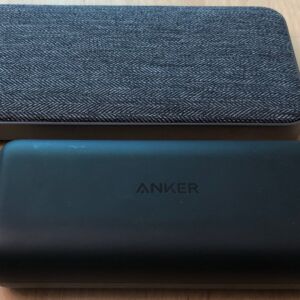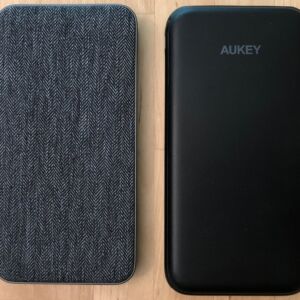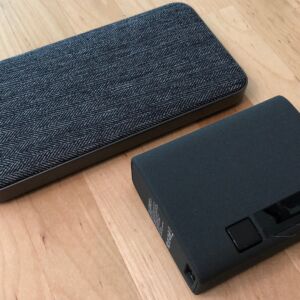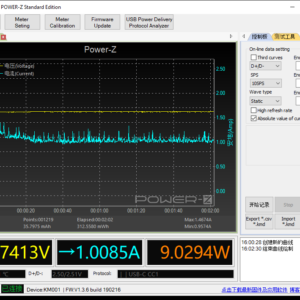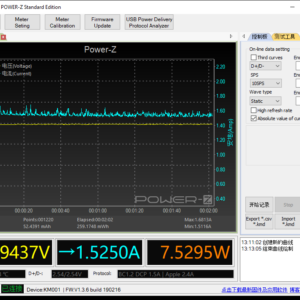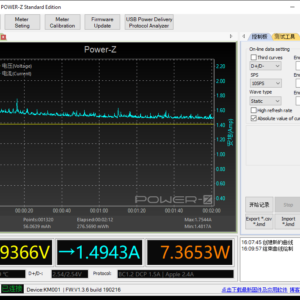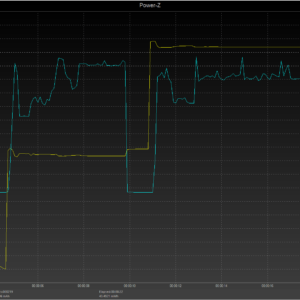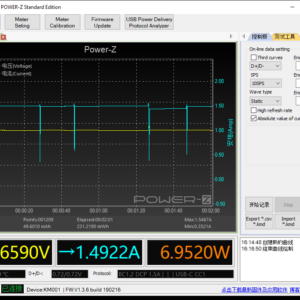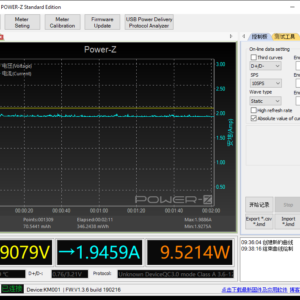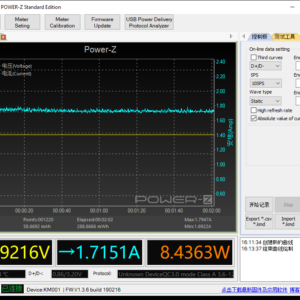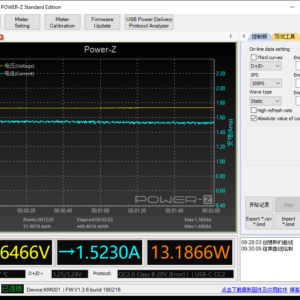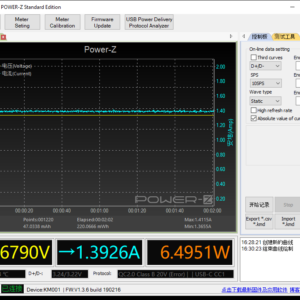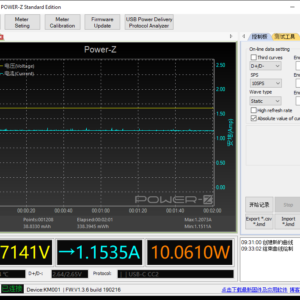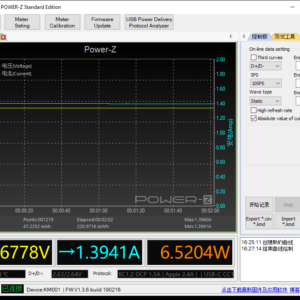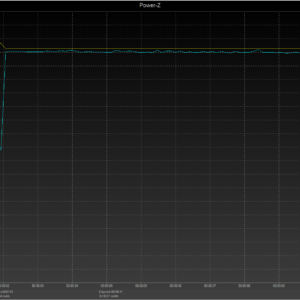ZMI PowerPack 10K USB-C - A business class power bank
Summary
The ZMI PowerPack 10K USB-C has a unique feature set. A USB adapter/low-power mode. A fabric covered exterior. But also a power saving function that disables fast charging when below 50% capacity.
Overall
-
Performance
(3.5)
-
Design
(5)
-
Safety
(4)
-
Recharge Time
(5)
User Review
( votes)Pros
- Fast charges iPhone, Samsung Galaxy, Google Pixel, and LG phones
- Charges Switch while you play
- Fits in most Switch carrying cases
- Low charging mode for Bluetooth headphones and fitness trackers
- USB adapter mode for laptops
- Supports pass through charging
- Includes a USB-C to USB-C cable
- Charge two devices at once, but at reduced rates
- Within FAA limits for lithium batteries and flights
Cons
- Won’t fast charge Motorola phones over USB-C
- Quick Charge over USB-C is against specs
- Can’t use USB-C PD and Quick Charge at the same time
Disclosure: As an Amazon Associate I earn from qualifying purchases. ZMI provided the product in this review.
Model: QB910
Tech Specs:
- Ports: USB-C, USB-A, micro-USB
- USB-C Output:
- 18W USB-C Power Delivery 2.0 (5V/3A, 9V/2A)
- Quick Charge 2.0 (5V/3A, 9V/2A, 12V/1.5A)
- Apple 2.4A
- USB-A Output:
- Quick Charge 2.0 (5V/3A, 9V/2A, 12V/1.5A)
- Apple 2.4A
- Input: 18W USB-C PD (5V/3A, 9V/2A)
- Capacity: 10,000mAh | 38.5Wh
- Size: 5.5 x 2.8 x 0.6 inches | 140 x 71 x 15 mm
- Weight: 7.4 oz | 210 grams
Learn more about Fast Charging.
Included In Box:
- ZMI PowerPack 10K USB-C
- USB-C to USB-C 2.0 cable, 22 inches
- micro-USB cable w/USB-C adapter, 12 inches (56k Ohm resistor)
Good For:
- Commute
- Travel
- iPhone
- Android
- Nintendo Switch (handheld)
- iPad Pro (pre-2018)
Estimated Charges:
- iPhone 6/7/8: 3.5 charges
- iPhone Plus/X/XR: 2 charges
- Samsung Galaxy S8/S9: 2 charges
- Samsung Galaxy S10: 2 charges
- Nintendo Switch: 4.5+ hours of play
First Impression
The ZMI PowerPack 10K USB-C (aka ZMI QB910) is product refresh of the ZMI QB810. ZMI told me many of their customers liked the QB810’s thin design. But newer iPhone and Pixel owners wanted USB-C PD output for fast charging. Which the new QB910 model provides.
This portable charger is also the first one I’ve seen with a woven fabric exterior. The material is a flame-retardant plastic, but looks and feels like rough fabric. Scratches and smudges are not an issue. And it doesn’t look out of place pulled out of a suit jacket pocket. In fact it won a reddot design award. It also won a snuggles award from one of my cats.
Compared To Similar Power Banks
| Power Banks | ZMI PowerPack 10K USB-C | Anker PowerCore 10000 PD Review | AUKEY PB-Y13 10000 USB-C Review | Xcentz xWingMan Dual 10000 Review |
|---|---|---|---|---|
| Output | 18W USB-C PD Quick Charge 2.0 | 18W USB-C PD | 18W USB-C PD Quick Charge 3.0 | 18W USB-C PD Quick Charge 3.0 |
| Capacity | 10,000mAh | 10,000mAh | 10,000mAh | 10,000mAh |
| Ports | USB-C USB-A micro-USB | USB-C USB-A | USB-C USB-A x2 micro-USB | USB-C USB-A |
| Features | Pass through charging Low power mode USB hub | Low power mode | Pass through charging | Pass through charging |
| Cable | USB-C to USB-C cable micro-USB cable w/USB-C adapter | USB-C to USB-C cable | USB-C to USB-A cable | USB-C to USB-A cable |
| Dimensions | 5.5 x 2.8 x 0.6 in 7.4 oz | 4.5 x 2 x 1 in 6.8 oz | 5.8 x 2.9 x 0.4 in 6.9 oz | 2.9 x 2.3 x 1 in 6.5 oz |
| Price | Price not available | Price not available | No products found. | No products found. |
Prices are from Amazon Product Advertising API, last updated on 2024-10-22.
You can see more USB-C power banks here.
Output Drops When >50% Capacity Remains
The ZMI QB910 has an interesting power saving feature. Some will like it, as it can enable longer run time for your device. Others won’t, as is lowers output and disabled fast charging.
When the power bank has 50% capacity or more remaining it behaves as expected. USB PD is available on the USB-C port. Or Quick Charge 2.0 is available on the USB-A port. But when the power bank is below 50% capacity it disables USB PD and Quick Charge in most cases. And reduces output below USB-C norms.
By dropping to 5V only it increases efficiency charging a USB device. The voltage down convert (going from output voltage to the device’s battery’s ~3.6V nominal voltage) is less. And by outputting fewer amps the total time it can output power is increased.
How Power Drop Affects Fast Charging
For newer iPhones this isn’t an issue. The USB-C to Lightning cable’s design forces USB PD to remain active until the phone is ~70% charged.
For Android phones at or near 100% charge already, this extends run time. But if your phone is ~20% it’ll take longer to get it above 50% charge.
For the Nintendo Switch it again depends on the charge level of the Switch’s own battery. Total playtime for a Switch at or near 100% is the same as with similar power banks. But the lowered output isn’t always enough to keep up with game demand. So a Switch well below 100% could see battery discharge. Though less than it would without any power bank.
There isn’t a way to disable this function. Other than to keep the power bank topped off above 50% itself. Best practice is to plug in your device often, keeping it above 50% as much as possible. This will remove the downsides of the function. And you may see a small boost in total uptime.
Device Testing
Check with your device’s manufacturer to verify which charging standards it supports.
USB Power Delivery & Quick Charge 4+ Phones
- Apple iPhone 8/X/XR/XS
- Essential Phone
- Google Pixel
- LG ThinQ/V30
- Razer
- Samsung Galaxy S8/S9/S10
- Samsung Galaxy Note 8/9
- Xiaomi Mi 8/9
- ZTE Axon Pro 9/10
Using an iPhone 8 for testing we find USB PD phones will fast charge over the USB-C port. iPhones will need to use a USB-C to Lightning cable, not included. And Android phones will need a USB-C to USB-C cable, which is included.
When below 50% capacity fast charging for the iPhone continues. I didn’t have a Google Pixel to test. But I would expect it to lose fast charging when the power bank is below half its capacity.
For iPhones the USB-A port supports Apple 2.4A. An older, but still functional fast charging standard. Older iPhones (4-7) can fast charge using USB-A. Newer iPhones will charge ~15 minutes faster using USB-C.
Quick Charge 3.0 Phones
- HTC
- LG
- Motorola
- Nokia
- Samsung Galaxy
- Sony
- Xiaomi Mi 5/6
- ZTE
Using a Moto G6 for testing we don’t see Quick Charge engage. So charging is at its normal rate. This is normal with Motorola phones when QC is offered over USB-C. But it also occurs over the USB-A port. It is likely an issue between Quick Charge 2.0 and Motorola TurboPower.
Samsung Galaxy, LG, and other QC supporting Android phones would be expected to fast charge.
The Moto G6’s charge rate does decrease a bit when the power bank’s capacity falls below 50%. I would expect all Quick Charging to be disabled as well.
Nintendo Switch
The Nintendo Switch charges near its max rate, up to 14W. The Switch won’t draw as much current as it could, which is 18W. This is due to a shortcoming with the Switch itself. But it is more than enough to charge while you play.
Learn more about charging the Switch.
When the power bank drops below 50% we see a big drop off in charge speed for the Switch. Almost half. The reduced rate will not always be enough to keep up with game play. If the Switch is at 100% when this occurs then it will remain at 100%. But if the Switch’s battery is also at a lower charge there may be more power loss. But total play time will still be more than with the Switch alone.
USB Adapter Mode/Low-Power Charging Mode
The ZMI QB910 supports a USB Adapter Mode, which doubles as a low-power charging mode. This is separate from the reduced output when below 50% mentioned above. These modes can be toggled on and off. And are designed for specific purposes.
To toggle on the modes press the portable charger’s power button twice. A blue LED will turn on next to the button. It will remain on and in this mode for 2 hours. Or you can turn it off by pressing the button again.
USB Adapter Mode
USB Adapter Mode allows you to use the portable charger as a USB-C to USB-A adapter for your laptop.
1. Plug the portable charger into your laptop via USB-C.
2. Plug a USB-A accessory, such as a flash drive, into the portable charger’s USB-A port.
3. The accessory will appear on the laptop. And will function at USB 2.0 speeds.
The portable charger is not a good option for charging the laptop. But it may save you from carrying one more USB-C dongle around. If you want this same function but with a portable charger that is rated to charge a laptop then check out the ZMI PowerPack 20000.
Low-Power Charging Mode
Low-power or trickle charging is for small accessories with little power draw. Such as Bluetooth headphones/earbuds and fitness trackers. They draw almost no current. And as such some portable chargers register them as not drawing power and shutdown. This prevents the accessory from charging.
In low-power charging mode the portable charger is forced to stay on for 2 hours. Giving the accessory plenty of time to charge before an auto shutdown occurs.
Reset Button and LED Indicators on ZMI Power Banks
With some power banks you push a button to get the LED indicators (aka fuel gauge) to light up. With ZMI power banks the button performs a reset of the power bank. This does light up the LEDs. But if the power bank is active (input or output) it will briefly interrupt the power flow as well. Power does reconnect on its own. And like a computer the occasional reset is good. So there’s no problem pushing the button. But with how ZMI LED’s behavior there shouldn’t be a need to push while in use.
When a ZMI power bank is charging a device the LEDs flash together. As its battery level drops, so do the number of flashing LEDs. So four blinking LEDs mean 75-100% capacity remaining. While three flashing LEDs mean 50-75% capacity. And so fourth in 25% increments. The flashing continues so long as the power bank is charging a device. Or until it is completely drained. So there is no need to do anything to check its status while active.
While charging a ZMI power bank the LEDs do a combination of solid on and flashing. The combination indicates current charge level. When completely drained only one LED will be flashing, with the rest unlit. After 25% recharged one LED will be solid, while another will start flashing. This continues at 25% increments. Until all four LEDs are solid, indicator a full charge. The LEDs will remain solid so long as the power bank stays connected to the charger. So again there is no need to do anything to check its status.
When the power bank is not connected to anything you’ll push the button to check its capacity. Again, this performs a reset on the power bank. But there’s no harm in doing so.
Pass Through Charging
Pass through charging allows a portable charger to both charge itself and a connected device. The power received from the wall charger splits. Some to the portable charger’s own batteries. And some to the connected device. How it handles the split varies. And there are more inefficiencies than normal.
This portable charger supports pass through charging under these connections:
Input: USB-C, Output: USB-A
- USB-C input drops to 5V, slowing down the portable charger’s recharge
- No Quick Charge available
Input: micro-USB, Output: USB-C, USB-A
- You can get power out of either the USB-C or USB-A ports
- No USB PD or Quick Charge available
Pass through charging is useful when you only have one USB wall charger. But it is not recommended to use this feature on a regular basis. It puts more heat and stress on the portable charger. Which will affect its lifespan. It can also provide an inefficient charge to your device. Again, not great for its own battery’s lifespan.
If you like to have the option when traveling, fine. But don’t set this up next to your bed at home every night.
Using the Included micro-USB Cable with USB-C Adapter
As a general rule it is safe to use a USB-C to micro-USB adapter. That is an adapter that turns a micro-USB connection into a USB-C connection. That’s the type of adapter included with this charger’s micro-USB cable.
It is not safe to use the opposite, turning a USB-C connection into a micro-USB connection. That would allow for connections against the USB standards and dangerous to devices.
My USB tester showed the micro-USB cable with USB-C adapter includes a 56k Ohm resistor. That resistor is required under USB-C specs for all USB-C to USB-A cables.
The cable charged my Moto G6 at the same rate as a regular USB-C to USB-A cable.
Quick Charge 2.0 Over USB-C
The presence of Quick Charge over USB-C is against USB-C specifications. Such chargers have been around for years without issue. But we don’t know what the future holds.
Under section 4.8.2 of USB-C specifications a proprietary charging method cannot change the voltage of USB-C output (between 4.40V and 5.25V) in a manner not defined by USB methods. Quick Charge operates at higher than default voltages. And so goes against the specifications. USB Power Delivery is an open source charging method. Created alongside USB-C, it is with specs even though it also increases voltage. The big difference is USB PD uses communication lines to negotiate power transfer. While proprietary methods take over the data lines for their negotiation. They do so because legacy USB connections, such as USB-A, don’t have comm lines.
There is no known risk with running proprietary charging standards over USB-C. Manipulating the data lines does disrupt data transfers. But when plugging into a wall charger or power bank there is no data transfer anyway. Some USB-C engineers warn against using any USB-C chargers with third party standards. Their concern is unforeseen consequences. Future technology may prove to be incompatible with such configurations. And pulling out a charger several years from now with a new device could have a bad result.
I have not run into any issues with these fast charging standards on this or any other charger. But as it is a spec violation I want you to be informed. If you’re a stickler for meeting USB-C specifications this isn’t a good charger for you. If you’re more pragmatic it works fine and has no known issues.
Summary
The ZMI PowerPack 10K USB-C is an interesting take on a 18W/10,000mAh portable charger. It has fabric covering exterior. Which handles the heat of a portable charger quite well. Its USB adapter/low-power charging mode offers options for laptop owners. And those with Bluetooth earbuds or fitness trackers. Its controversial feature is the reduction in output when below 50% capacity. It extends run time. But disables fast charging without an override.
For phones it fast charges iPhone 8/X/XR/XS and Google Pixel. It should also fast charge Samsung and LG phones. And any other Android which supports Quick Charge. It won’t fast charge Motorola phones, but will charge them and any other USB-C phone at their normal rate.
For the Nintendo Switch it charges in handheld mode while you play. Provided the portable charger itself is above 50% charged. In its lower power mode it’ll maintain a Switch at 100%.
When the portable charger is below 50% capacity it reduces its output for most devices. Newer iPhones being the notable exception. This increases efficiency and runtime. But it slows down charging below normal USB-C rates. Let alone no fast charging. If your device is >70% charged it helps. If you run it down near 0% it can be a pain.
The USB adapter mode can replace a USB-C to USB-A adapter in your bag. It allows the portable charger to provide the same function. But keep in mind the portable charger will not provide a good charge to the laptop.
The same mode will keep the portable charger awake. Allowing it to trickle charge your Bluetooth headphones or fitness tracker.
About ZMI
ZMI USA has U.S. based support (web, email, phone) and a 18 month warranty. They were founded in the USA and are backed financially by Zimi Corporation. Zimi is the exclusive mobile power accessory supplier to Xiaomi.
Bottom Line
The ZMI PowerPack 10K USB-C is a power bank that covered several niches. The most interesting being business men with laptops, but who only need a phone charger. Or cats who like to snuggle with warm, soft things.
Buy if you:
- Want a unique looking (and feeling) power bank
- Need trickle charging support for a Bluetooth headphone or fitness tracker
- Have occasional need for a USB-C to USB-A adapter, but not to remote charge your laptop
Don’t buy if you:
- Have a Motorola phone, or want Quick Charge 3.0 support
- Aren’t keen on the output drop that occurs >50% to save battery time
- Aren’t comfortable with the USB-C spec violation
You’ll want a USB-C wall charger to quickly recharge this USB-C power bank. I recommend the ZMI PowerPlug Turbo. Its 45W USB-C PD is more than you need with this power bank. But you’ll be hard pressed to find an 18W USB-C PD wall charger with USB-C cable for less.
Be sure to check the Deals page to see if this or a similar charger is on sale.







